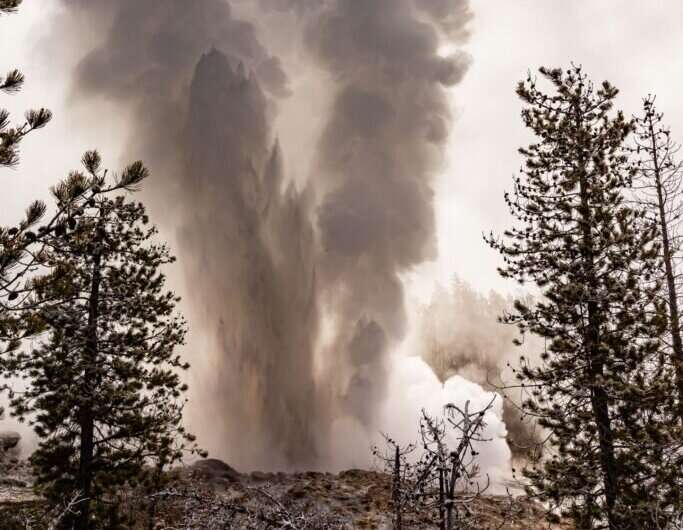This article has been reviewed according to Science X's editorial process and policies. Editors have highlighted the following attributes while ensuring the content's credibility:
fact-checked
trusted source
proofread
Petrified trees reveal Yellowstone geyser's ongoing battle with drought

Yellowstone's Steamboat Geyser has had decades-long dry spells brought on by a history of droughts, a new study finds. With global temperatures on the rise, the American West is projected to become drier. Sustained drought in this region could slow down, and possibly halt, Yellowstone National Park's famous geyser eruptions, the researchers say.
"Even small changes in precipitation could affect the interval between eruptions," explained Shaul Hurwitz, a hydrologist at the United States Geological Survey (USGS) who led the study. "So more water means more frequent eruptions, while less water means less frequent eruptions."
Geysers need very specific conditions to form, including a water source, heat supply, and the right geologic plumbing. Environmental conditions such as drought can tip that balance and cause geysers to go dormant. The new study, published in Geochemistry, Geophysics, Geosystems, used partially mineralized wood by Steamboat Geyser to reconstruct its past periods of inactivity and determine what caused the geyser's dry spells.
Steamboat, the world's tallest active geyser, can spray water up to about 115 meters (377 feet) into the air for as long as 90 minutes at a time. Unlike the park's Old Faithful Geyser, Steamboat does not erupt on a predictable schedule, with eruption intervals ranging from just three days to 50 years, according to the USGS. Now, researchers are looking to understand why the geyser's activity has waxed and waned over the centuries.
When Steamboat erupts, the geyser's heated water spray coats nearby trees in silica, a mineral that can prevent decomposition. This silica mist slowly smothers the trees, eventually killing them while preserving the wood's structure. As a result, dead trees surrounding the geyser can be preserved for centuries longer than usual, making them a useful tool for studying the geyser's history.
"In Yellowstone, you rarely find any wood, even dead wood, that's more than 300 years old because the fungi and other bacteria decompose it," Hurwitz said. "The silica essentially protects the tree from the fungi. For us, this is an advantage because if they weren't silicified we wouldn't have any trees to date."
Lodgepole pines make up nearly all of Yellowstone's forests. However, they have an average lifespan of only 150 to 200 years. Hurwitz and his team took advantage of this preservation process and collected silicate wood samples from within 14 meters (46 feet) of the geyser vent. Through radiocarbon dating, they found that the tree samples clustered around three time periods: the late 15th century, mid-17th century and late 18th century.
"Water that is erupting from the geyser is silica-rich, and when silica precipitates it clogs pathways that allow the trees to respire, photosynthesize and grow," Hurwitz explained. "For us, this indicates that when trees grow right near the mound there are no eruptions."
Hurwitz and his team matched the three periods of tree growth around the geyser to regional climate records and found that droughts occurred during the same time that the trees grew. These environmental conditions most likely reduced the local water supply, preventing Steamboat from erupting and allowing the trees to grow—but the geyser hasn't remained dormant for long.
"In the case of Steamboat, we did not find any tree remnant of silicified wood that had more than 10 or 20 annual rings, which suggests to us that trees never grew big around that area," Hurwitz said. "So, there wasn't an extended period of many decades or centuries with continuous growth."
But with global temperatures on the rise, extended drought in America's West could further diminish Yellowstone's geyser activity.
"As we're headed toward what's predicted to be a warmer and drier climate in the 21st century, we might expect to see the geysers go to totally different behavior in terms of the interval between their eruptions—erupting less frequently, and some of them might even go extinct," Hurwitz said.
Popular geysers such as Old Faithful could become less "faithful" to their eruption schedules as their water supply lessens. According to Hurwitz, these changes in geyser activity could have long-term implications for how Yellowstone National Park manages visitation overall.
More information: Shaul Hurwitz et al, The Relation Between Decadal Droughts and Eruptions of Steamboat Geyser in Yellowstone National Park, USA, Geochemistry, Geophysics, Geosystems (2023). DOI: 10.1029/2023GC010988
Provided by American Geophysical Union



















